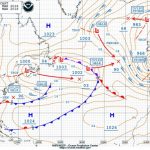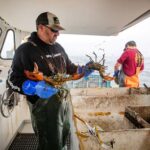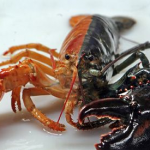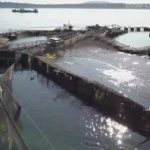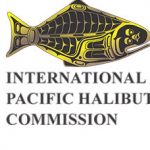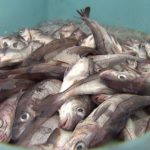Tag Archives: Oregon Department of Fish and Wildlife
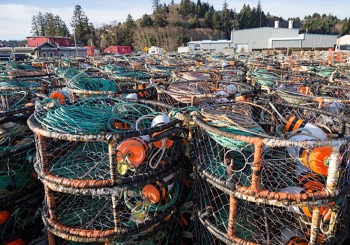
Crab industry, Oregon continue plans to avoid whale entanglement
New regulations for commercial Dungeness crab fishermen in Oregon aim to get boats on the water earlier in the season and reduce the amount of gear to avoid tangling with endangered whales. “Our fleet is made up of 400 individual businesspeople who each bring a different perspective to the issue,” said Hugh Link, the executive director of the Oregon Dungeness Crab Commission. “For over three years, they have been given the opportunity to weigh in on how best to mitigate the whale entanglement risk,” he continued. “But it is an ongoing process. These upcoming meetings are the next important step and we hope they take the opportunity to have their voices heard.”
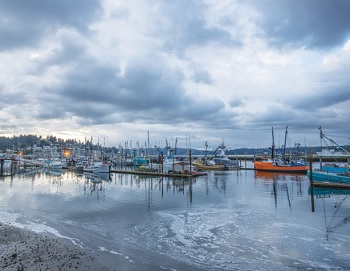
Coronavirus: Yaquina Bay fishing continues despite market disruptions
As part of the food-production chain, commercial fishing is considered an essential industry, but even though fishermen based out of Newport’s Yaquina Bay are still on the job, they have felt the impact of the current market disruptions stemming from the COVID-19 pandemic.,, “Some crabbers are still trying to stick it out, others have probably called it earlier than they normally would,” Buell added. “There still is some effort happening, for sure. It’s kind of hard to keep up with everything, but it sounds like the Chinese markets may be opening back up a little bit, so they’re able to start moving some live crab there, which is helping.” >click to read< 07:47
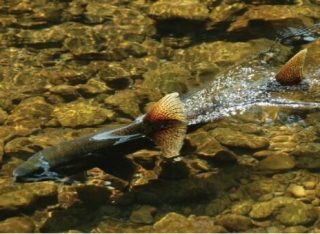
Columbia River Salmon Rules Set
The directors of the Washington and Oregon departments of Fish and Wildlife reached an agreement this week on allocations and gear types for Columbia River salmon fisheries in 2020. The Washington and Oregon Fish and Wildlife commissions earlier this year delegated development of 2020 Columbia River fisheries to Oregon Department of Fish and Wildlife (ODFW) Director Curt Melcher and Washington Department of Fish and Wildlife (WDFW) Director Kelly Susewind. >click to read< 12:10

An experiment on the river – Researchers hope fish trap will be safer for wild fish
Fish traps have been outlawed in the Pacific Northwest for decades, but researchers plan to test an experimental trap in the Columbia River in hopes that it will be safer for wild fish than traditional fishing methods. Adrian Tuohy, a biologist and project manager for the Wild Fish Conservancy, said the proposed fish trap, also called a pound net, would be put in the Oregon side of the river so biologists can monitor how many fish are in the river and how many wild fish survive after being released. >click to read< 16:36
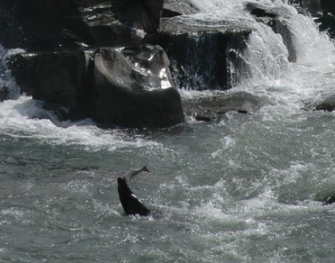
Oregon seeking expanded sea lion controls following success of salmon protections at Willamette Falls, Bonneville Dam
Having fended off the threat of extinction of wild winter steelhead over Willamette Falls, Oregon biologists are now joining counterparts in Washington, Idaho and Native American tribes to expand that success. Tuesday is the deadline set by the National Marine Fisheries Service for comments on a state and tribal proposal to reduce protections for both California and Steller sea lions in the Columbia river and its tributaries…. Send comments to: https://www.regulations.gov/docket?D=NOAA-NMFS-2019-0073, or mail them to the National Marine Fisheries Service, ATTN: Protected Resources Division, NOAA-NMFS-2019-0073; 1201 NE Lloyd Blvd., Suite 1100; Portland, Ore., 97232. >click to read< 11:52
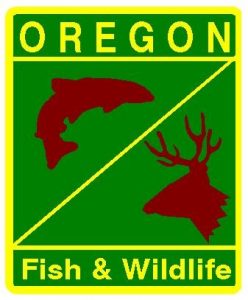
ODFW using grant to track whales on Oregon Coast, reduce fishing gear entanglements
The Oregon Department of Fish and Wildlife received a $278,856 federal grant Friday to help fund its program to improve environmental conditions for whales off the Oregon Coast by reducing the risk of whales entangled in fishing gear. The Funded Species Recovery grant, awarded by National Oceanic and Atmospheric Administration, was announced Aug. 9, by U.S. Sens. Ron Wyden and Jeff Merkley, both Oregon representatives. >click to read< 10:32
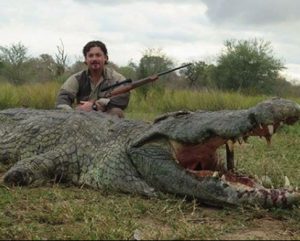
Wildlife conservation groups say Gov. Brown has sold them out in favor of ranchers, hunters and commercial fishers.
The Oregon conservation community was shocked this week by the nomination of a big game hunter to the state’s Fish and Wildlife Commission, saying the nominee has shown a disdain for animals and has conflicts of interest. James Nash, a retired marine, hunting guide and rancher who lives in Wallowa County, was tapped by Gov. Kate Brown,,,, >click to read< And they describe it as a betrayal by a governor who they say pledged during her re-election campaign last year to protect the threatened species—but, after winning, picked nominees favoring groups that include ranchers, loggers and commercial fishermen, and hunters whose economic interests may conflict with the desires of a majority of Oregonians. >click to read<14:02
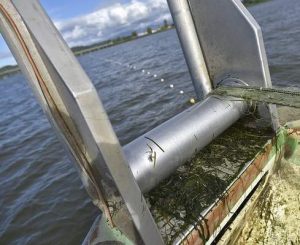
A major policy change – Washington State will allow gillnets in lower Columbia this fall
The Washington Fish and Wildlife Commission has agreed to allow the use of gillnets during the fall salmon fishery on the lower Columbia River while state fishery managers work with their Oregon counterparts to develop a joint, long-term policy for shared waters. The move is a major change in policy. Washington policy, approved in 2013, intended for the commercial fishery to have completed a transition from gillnets to alternative gear this year and be relocated away from mainstem Columbia River areas. However, the use of alternative gear has not yet been refined and the off-channel areas have been determined to be unsuitable. >click to read<10:05
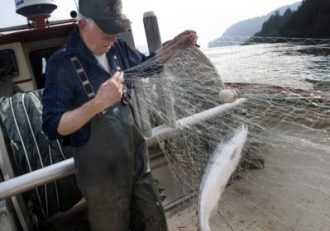
Kitzhaber’s Columbia River Reform – Gill-net issue still tangled
The Joint State Columbia River Salmon Policy Review Committee met for the first time on Jan. 17 at the Oregon Department of Fish and Wildlife headquarters in Salem, Ore. The six-member task force is charged with revising the Columbia River policy C-3620. The policy was implemented in an effort to remove non-tribal gill nets used by the commercial fishing fleets of both states from the mainstem Columbia River after an exhaustive years-long process. It was sought by sport anglers and conservationists who have long objected to commercial fishing on salmon and steelhead stocks that are federally listed as endangered. >click to read<18:39
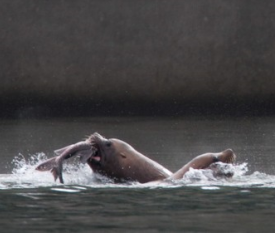
Oregon starts killing fish-eating sea lions
Oregon wildlife officials have started killing California sea lions that threaten a fragile and unique type of trout in the Willamette River, a body of water that’s miles inland from the coastal areas where the massive carnivorous aquatic mammals usually congregate to feed. The state Department of Fish and Wildlife obtained a federal permit in November to kill up to 93 California sea lions annually below Willamette Falls south of Portland to protect the winter run of the fish that begin life as rainbow trout but become steelhead when they travel to the ocean. >click to read<15:57
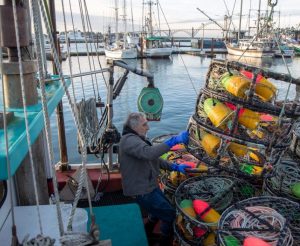
Crabbers to sail into storm
Fishermen face high seas and uncertain prices as they set out Friday, Jan. 4, for the opening day of Dungeness crab season. “The weather’s been terrible but we hope to be processing by Friday night,” reported John Moody, manager of Pacific Seafood Group’s plant in Newport. A score of vessels left port under sunny skies Tuesday to drop pots for the “pre-soak,” enabling fishermen to land crab at the opening bell. But 50-55 mph gusts and 20-foot swells that were predicted to arrive Thursday night could mean further holdups for some boats. >click to read<10:15

Dungeness crab season to officially open in January for parts of the Oregon coast
After a month-long delay, the Dungeness crab season is set to open at the beginning of January in Oregon, but industry experts say these appear to be a trend and they hurt coastal communities. Oregon’s Department of Fish and Wildlife will open the crabbing season for the central and northern coast. Fishermen can set their pots on Jan. 1 and begin pulling them on Jan. 4. It was supposed to open on Dec. 1. Officials delayed the season because there was not enough meat in the crabs. Rough weather also delayed testing. If all goes according to plan, you may be able to find crab in the markets by about Jan. 10, according to sellers. >click to read<13:39
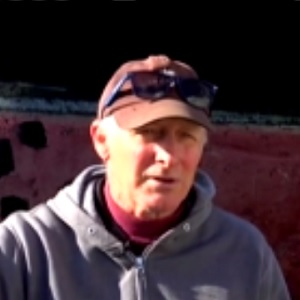
Oregon Crabber: ‘We’ll wait for a better price instead of going out fishing for less of a price’
Local crabbers are once again bracing for a problem they know all too well. The start of the commercial Dungeness crab season is being delayed until December 16 – at the earliest.,, Jeff Sober, a crabber of almost 40 years, said it happens frequently. He is always ready by December – but saves money just case. “We’re just going to be delayed. The season will happen eventually,” he said. “We do have a Christmas market. If we miss out on that, we’ll probably miss out on some money.” >click to read<19:38
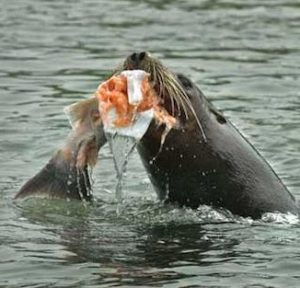
NMFS approves plan for state officials to kill sea lions at Willamette Falls
Protected under the Marine Mammal Protection Act, the state needed federal approval to take lethal action against the pinnipeds, which have been observed gorging themselves on endangered fish at the foot of the iconic waterfall. “This is good news for the native runs of salmon and steelhead in the Willamette River,” said Shaun Clements, a policy analyst for the state on the sea lion issue. “Before this decision, the state’s hands were tied as far as limiting sea lion predation on the Willamette River.” >click to read<22:52
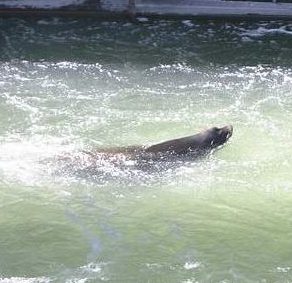
Sea lions continue to eat endangered fish
All the time, money and sacrifice to improve salmon and steelhead passage in the Willamette River won’t mean a thing unless wildlife managers can get rid of sea lions feasting on the fish at Willamette Falls. That was the message Tuesday from Shaun Clements, senior policy adviser for the Oregon Department of Fish and Wildlife, who met at the falls with Liz Hamilton, executive director of the Northwest Sportfishing Industry Association, and Suzanne Kunse, district director for U.S. Rep. Kurt Schrader, D-Ore. >click to read<17:51

Oregon Fish and Wildlife Commission adopts new rules for Dungeness crab
Harmful algal blooms complicated commercial Dungeness crab seasons on the Oregon Coast for the past three seasons, threatening the viability of the state’s most valuable fishery.,,The new rules outline evisceration protocols that go into place when levels of the naturally occurring marine toxin domoic acid spike. The toxin can accumulate at high levels in a crab’s guts, but remove the guts and the meat is still safe to eat. The rules also establish 12 distinct crabbing zones on the Oregon Coast, narrowing the areas that can be closed or opened at any given time. >click to read<22:42

Oregon Department of Fish and Wildlife – Relocation of sea lions not enough to protect Willamette fish runs
Over 25 California sea lions and an unknown number of Steller sea lions continue to prey on salmon, steelhead, sturgeon, and lamprey in the Willamette River this month. In the absence of federal approval to lethally remove the California sea lions at Willamette Falls, ODFW attempted a stop gap program of capturing and relocating sea lions this spring. “It’s our responsibility and mandate from the people of Oregon to ensure these fish runs continue,” said Dr. Shaun Clements, ODFW’s senior policy advisor. “So it’s incredibly frustrating to us that federal laws prevent us from taking the only steps effective at protecting these fish from predation.” >click to read<13:49

New sea lion wrinkle in the Willamette River threatens sturgeon
Oregon biologists attempting to save the Willamette River’s sharply declined winter steelhead run are facing a new twist in their vexing battle against fish-hungry sea lions at Willamette Falls. The river has seen an unusual influx this winter of large, sturgeon-eating Steller sea lions. Anglers from the falls to the Portland harbor report watching the carnage. “Sturgeon are on our radar,” said Shaun Clements of the Oregon Department of Fish and Wildlife. “We have seen up to 10 Steller sea lions at the falls, which is more than typical.” >click to read<18:24
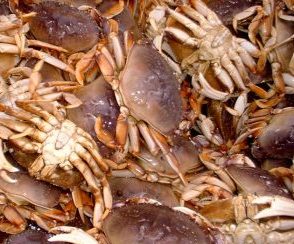
A bad season for crab – Domoic acid levels high again, meat content poor, crustaceans start to molt
The Oregon Department of Agriculture is ordering crab fishermen to eviscerate or destroy any crab caught since Feb. 13 after tests Wednesday showed domoic acid is again at unacceptable levels. There is also a recall on all live or whole-cooked crab caught since Feb. 13, said Troy Buell, fishery manager with Oregon Department of Fish and Wildlife. Recreational crabbing in Curry County has also been closed. The news comes nine days after the long-delayed crabbing season opened in the last section on the Oregon Coast. >click to read< 09:01

Oregon commercial crab fishery to open Jan. 15
The commercial Dungeness crab fishery will open on most of Oregon’s coast on Jan. 15. Dungeness crab will be ready to be harvested from Cape Blanco to the Columbia River and north into Washington. While the commercial season can open as early as Dec. 1, the opening can be delayed to ensure a high quality product for consumers by allowing crabs more time to fill with meat, according to the Oregon Department of Fish and Wildlife. click here to read the story 12:42

Dwindling winter steelhead are on their own again at Willamette Falls
With the first four dozen winter steelhead counted at Willamette Falls and scattered early catches reported in both the Clackamas and Sandy rivers, Oregon scientists, fish managers, anglers and others must helplessly hold their figurative breath. Sea lions, which chewed through as much as 25 percent of the dismal return of 2016-17 steelhead, pretty much have free rein this winter to repeat the carnage. “The impact, if left un-managed, will be pretty devastating,” said Shaun Clements, senior fish division policy advisor for the Oregon Department of Fish and Wildlife. click here to read the story 16:11
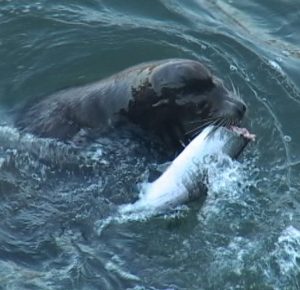
Oregon Eyes Killing Sea Lions to Save Steelhead Trout
Fish managers scrambling to gain approval to kill dozens of California sea lions feasting on threatened winter steelhead trout got a bump this week from a study blaming the creatures for taking food from orcas. But some say the effort is a misguided attempt to scapegoat natural predators for the human-caused decline of their prey. In 1999, about 15,000 winter steelhead passed Willamette Falls. In 2016, scientists with the Oregon Department of Fish and Wildlife counted just 512.,, “We’re looking at a threat of extinction posed by sea lions,” Shaun Clements, the agency’s senior fish policy advisor, told the Fish and Wildlife Commission at a meeting in September. click here to read the story 08:04

NOAA/NMFS seeks input on proposed sea lion removal at Willamette Falls
NOAA Fisheries is seeking public input on an application from the Oregon Department of Fish and Wildlife (ODFW) to remove, by lethal means if necessary, California sea lions preying on endangered and threatened salmon and steelhead at Willamette Falls on the Willamette River near Oregon City. The approach would be similar to the ongoing removal of sea lions preying on vulnerable populations of protected fish at Bonneville Dam on the Columbia River. Under the Marine Mammal Protection Act (MMPA), each application NOAA Fisheries receives for removing problematic sea lions must undergo independent consideration. info, click here to read the story 08:36
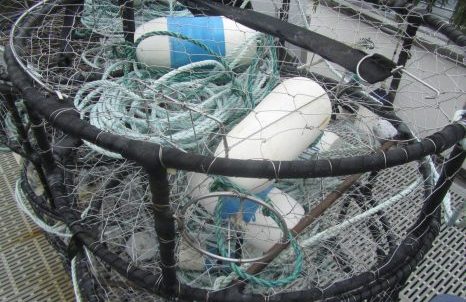
Oregon delays start of Dungeness crab season by more than 2 weeks
The traditional Dec. 1 opening of the commercial Dungeness crab season will be delayed until at least Dec. 16 along the entire Oregon coast as testing shows crabs are too low in meat yield.,, Crab quality testing in early November showed that none of the test areas met the criteria for a Dec. 1 opening. The delayed opening will allow for crabs to fill with more meat. click here to read the story 15:58
“Last year’s season opening was also delayed but still brought in the highest ex-vessel value ever ($62.7 million) with 20.4 million pounds landed, about 22 percent above the 10-year average,” the Oregon Department of Fish and Wildlifre said in a statement. click here to read the story
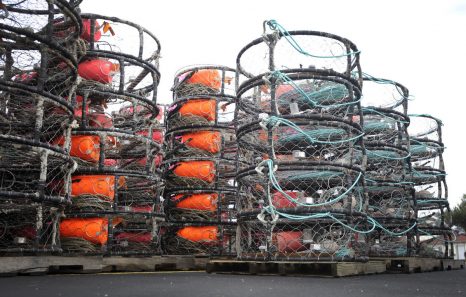
Oregon: Bay crabbing closures leave businesses empty
The Oct. 15 closure of both recreational and commercial crabbing came as quite a surprise to many local businesses who rely on bay crabbing in the months leading up to the Dec. 1 ocean crabbing season.,,, The Oregon Department of Fish and Wildlife along with the Oregon Department of Agriculture closed crabbing after noticing increased levels of domoic acid in local Dungeness crabs coming out of the bay. However, locals who financially rely on crabbing feel this isn’t as dangerous as state agencies are making it out to be. click here to read the story 09:08
The Ocean’s Low-Oxygen Dead Zones Are Getting Worse
 Along the West Coast, low-oxygen levels in bottom layers of the ocean, known as hypoxia, have become a big concern for scientists and fishers alike—fish and crabs are vital to ecosystems, research, and an entire industry. “We’re always on the lookout to see, is this going to be a bad year?” says Francis Chan, a marine ecologist at Oregon State University who studies the effects of ocean chemistry. And by all accounts, 2017 shaped up to be a bad year. Scientists first got reports of crabs dying in pots off the Oregon coast back in 2002. Since then, says Chan, there have been some years when the oxygen levels in some places drop to zero and stay that way for weeks or even months. Video, click here to read the story 17:16
Along the West Coast, low-oxygen levels in bottom layers of the ocean, known as hypoxia, have become a big concern for scientists and fishers alike—fish and crabs are vital to ecosystems, research, and an entire industry. “We’re always on the lookout to see, is this going to be a bad year?” says Francis Chan, a marine ecologist at Oregon State University who studies the effects of ocean chemistry. And by all accounts, 2017 shaped up to be a bad year. Scientists first got reports of crabs dying in pots off the Oregon coast back in 2002. Since then, says Chan, there have been some years when the oxygen levels in some places drop to zero and stay that way for weeks or even months. Video, click here to read the story 17:16
Herrera Beutler: To save steelhead, we must cut sea lion numbers
 Steelhead, longtime residents in our rivers here in the Pacific Northwest, are now approaching extinction with alarming speed. This isn’t exaggeration; the Oregon Department of Fish and Wildlife found that one population of steelhead has an 89 percent chance of becoming extinct in the not too distant future. The culprit for the fish’s demise? Sea lions. Experts are pointing to the increased population of California sea lions as the biggest threat. The sea lions gather in locations where steelhead and salmon are the most vulnerable, like below the Willamette Falls or the Bonneville Dam, where these native fish species congregate before heading upstream to spawn. An alarmingly low number of native steelhead — just 512 — made it over Willamette Falls this year. click here to read the story 10:01
Steelhead, longtime residents in our rivers here in the Pacific Northwest, are now approaching extinction with alarming speed. This isn’t exaggeration; the Oregon Department of Fish and Wildlife found that one population of steelhead has an 89 percent chance of becoming extinct in the not too distant future. The culprit for the fish’s demise? Sea lions. Experts are pointing to the increased population of California sea lions as the biggest threat. The sea lions gather in locations where steelhead and salmon are the most vulnerable, like below the Willamette Falls or the Bonneville Dam, where these native fish species congregate before heading upstream to spawn. An alarmingly low number of native steelhead — just 512 — made it over Willamette Falls this year. click here to read the story 10:01
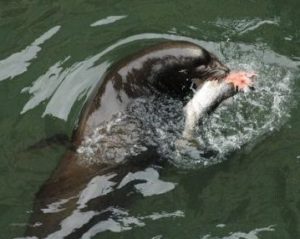
Report: Sea lions push Willamette River steelhead to brink of extinction
State wildlife officials say wild steelhead in the upper Willamette Basin could go extinct in coming years because of sea lions feasting on the iconic fish at Willamette Falls. The Statesman Journal reported in June that wild steelhead numbers hit all-time lows this year due to poor ocean conditions, historic drought and the long-term effects of habitat loss. But in an explosive report made public Monday, officials say sea lion predation could tip the scales toward extinction in rivers including the Santiam, Molalla and Calapooia, all Willamette tributaries. “We’ve reached the point where, unless we take some action, we may condemn this run to extinction,” said Dr. Shaun Clements, senior scientist and fish policy advisor for the Oregon Department of Fish and Wildlife. “We need to act now or extinction may be our legacy.” Video, click here to read the story 21:33
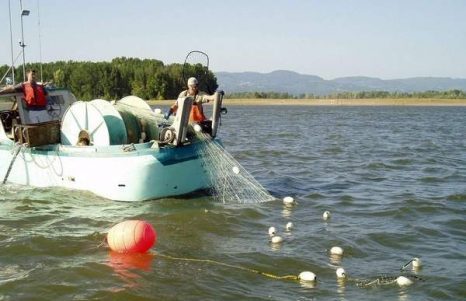
The Columbia River Fisheries Transition Fund – Money for gillnetters has never been tapped
A fund that was supposed to provide commercial fishermen $1.5 million to adjust to new regulations curtailing gillnetting in the Columbia River has never been tapped. The Columbia River Fisheries Transition Fund, a 2013 creation of the Legislature, was supposed to set aside $500,000 every two years to provide financial assistance to gillnetters through 2019. The money was intended to help fishermen buy replacement gear and offset economic harm due to the expected phasing out of gillnetting in the lower main stem of the Columbia. The money has not been used yet, and after some of it was reverted back to the general fund due to an accounting error at the state Department of Fish and Wildlife, the Legislature is now poised to do away with the last $500,000 installment. That leaves $500,000, a third of the amount initially intended, and it’s not immediately apparent whether gillnetters will end up applying for or receiving the money. click here to read the story 13:42
Washington discusses tangle-net chinook fishery
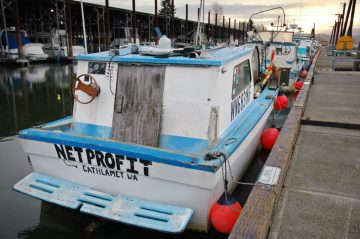 Washington’s Fish and Wildlife Commission on Friday deliberated — but took no vote — on whether a commercial tangle-net spring chinook salmon fishery would be acceptable this year in the lower Columbia River. Washington and Oregon have slightly different polices for managing the Columbia River, the result of the Columbia River reforms process that began in 2013 and go into full implementation this year. Jim Unsworth, director of the Washington Department of Fish and Wildlife, and Curt Melcher, director of the Oregon Department of Fish and Wildlife, have been delegated authority to negotiate the differences, but the talks are not concluded. click here to read the story 15:42
Washington’s Fish and Wildlife Commission on Friday deliberated — but took no vote — on whether a commercial tangle-net spring chinook salmon fishery would be acceptable this year in the lower Columbia River. Washington and Oregon have slightly different polices for managing the Columbia River, the result of the Columbia River reforms process that began in 2013 and go into full implementation this year. Jim Unsworth, director of the Washington Department of Fish and Wildlife, and Curt Melcher, director of the Oregon Department of Fish and Wildlife, have been delegated authority to negotiate the differences, but the talks are not concluded. click here to read the story 15:42


































